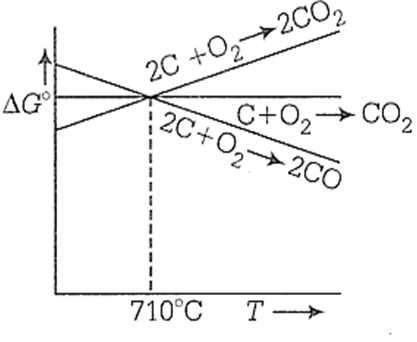 Multiple Choice Questions
Multiple Choice QuestionsWhen KMnO4 acts as an oxidising agent and ultimately forms Mn MnO2, Mn2O3 and Mn2+ then the number of electrons, transferred in each case respectively are
1, 3, 4, 5
3, 2, 1, 4
1, 5, 3, 7
4, 3, 2, 1
In acidic medium, dichromatic ion oxidises ferrous ion to ferric ion. If the gram molecular weight of potassium dichromate is 294 g its gram equivalent weight (in grams) is
24.5
49
125
250
Point out the correct statement.
Below 710C, C is better reducing agent than CO
Below 710°C, CO is better reducing agent than C
Below 710C, CO is an oxidising agent
Below 710C, CO, is a reducing agent
B.
Below 710°C, CO is better reducing agent than C
Among all the statements given, statement b is correct.
Below 710C, CO is better reducing agent than CO. It can depicted by using the following graph

KMnO4 reacts with ferrous sulphate according to the following equation,
Mn + 5Fe2+ + 8H- Mn2+ + 2Fe3+ + 4H2O
Here, 10 mL of 0.1M KMnO4 is equivalent to
50 mL of 0.1 M FesO4
20 mL of 0.1 M FesO4
40 mL of 0.1 M FesO4
30 mL of 0.1 M FeSO4
Which of the following species do not show disproportionation on reaction?
ClO-, Cl , Cl and Cl
Cl
Cl
ClO-
None of these
For the reaction,
NH3 + OCl- N2H4 + Cl-
occurring in basic medium, the coefficient of N2H4 in the balanced equation will be
1
2
3
4
In an oxidation-reduction reaction, MnO ion is converted to Mn2+. What is the number of equivalents of KMnO4 (mol. wt.= 158) present in 250 mL of 0.04 M KMnO4 solution ?
0.02
0.05
0.04
0.07
Which of the following is wrong statement?
Ni(CO)4 has oxidation number +4 for Ni
Ni(CO)4 has zero oxidation number for Ni
Ni is metal
CO is gas
